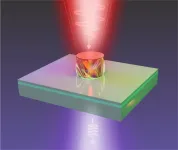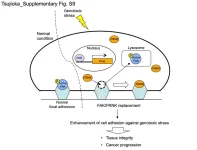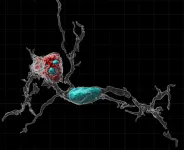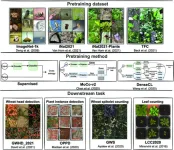(Press-News.org) Physicists at The Australian National University (ANU) are using nanoparticles to develop new sources of light that will allow us to “peel back the curtain” into the world of extremely small objects – thousands of times smaller than a human hair – with major gains for medical and other technologies.
The findings, published in Science Advances, could have major implications for medical science by offering an affordable and effective solution to analyse tiny objects that are too small for microscopes to see, let alone the human eye. The work could also be beneficial for the semiconductor industry and improving quality control of the fabrication of computer chips.
The ANU technology uses carefully engineered nanoparticles to increase the frequency of light that cameras and other technologies see by up to seven times. The researchers say there is “no limit” to how high the frequency of light can be increased. The higher the frequency, the smaller the object we are able to see using that light source.
The technology, which requires only a single nanoparticle to work, could be implemented into microscopes to help scientists zoom into the world of super small things at 10 times the resolution of conventional microscopes. This would enable researchers to study objects that would otherwise be too small to see, such as the inner structures of cells and individual viruses.
Being able to analyse such small objects could help scientists better understand and fight certain diseases and health conditions.
“Conventional microscopes are only able to study objects bigger than about a ten-millionth of a metre. However, there is growing demand across a range of sectors, including the medical field, to be able to analyse much smaller objects down to one billionth of a metre,” lead author Dr Anastasiia Zalogina, from the ANU Research School of Physics and the University of Adelaide, said.
“Our technology could help meet that demand.”
The researchers say the ANU-developed nanotech could help create a new generation of microscopes that can produce much more detailed images.
“Scientists who want to generate a highly-magnified image of an extremely small, nanoscale object can’t use a conventional optical microscope. Instead, they must rely on either super-resolution microscopy techniques or use an electron microscope to study these tiny objects,” Dr Zalogina said.
“But such techniques are slow and the technology is very expensive, often costing more than a million dollars.
“Another disadvantage of electron microscopy is that it may damage delicate samples being analysed, whereas light-based microscopes mitigate this issue.”
Beams of light that we perceive as different colours of the rainbow are electromagnetic waves that oscillate with different frequencies.
What we see as red is the lowest frequency that our eyes can detect. Even lower frequencies not visible to the human eye are called infra-red. Violet has the highest light frequency that we can see. Ultraviolet, which has an even higher frequency, is invisible to the human eye.
Although our eyes cannot detect infra-red and ultraviolet light, it is possible for us to ‘see’ it using cameras and other technologies.
Co-author Dr Sergey Kruk, also from ANU, said researchers are interested in achieving very high frequencies of light, also known as ‘extreme-ultraviolet’.
“With violet light we can see much smaller things compared to using red light. And with extreme-ultraviolet light sources we can see things beyond what’s possible using conventional microscopes of today,” Dr Kruk said.
Dr Kruk said the ANU technology could also be used in the semiconductor industry as a quality control measure to ensure a streamlined manufacturing process.
“Computer chips consist of very tiny components with feature sizes almost as small as one billionth of a metre. During the chip production process, it would be beneficial for manufacturers to use tiny sources of extreme-ultraviolet light to monitor this process in real-time to diagnose any problems early on,” he said.
“That way manufacturers could save resources and time on bad batches of chips, thereby increasing yields of chip manufacturing. It’s estimated that a one per cent increase in yields of computer chip manufacturing translates into two billion dollars in savings.
“Australia’s booming optics and photonics industry is represented by nearly 500 companies and accounts for about $4.3 billion of economic activity, making our high-tech ecosystem well positioned to adopt new types of light sources in order to reach new global markets in nanotechnology industries and research.”
This work was conducted in collaboration with researchers from the University of Brescia, the University of Arizona and Korea University.
END
Nifty nanoparticles help ‘peel back the curtain’ into the world of super small things
2023-04-26
ELSE PRESS RELEASES FROM THIS DATE:
Tree diversity increases carbon storage, soil fertility in forests
2023-04-26
Keeping tree diversity intact in Canada’s many forests over the long term can help increase carbon capture and mitigate climate change, according to a new University of Alberta study.
The study, published in Nature, is the first of its kind to show the sustained benefits of tree diversity on a large spatial scale, in terms of storing carbon and nitrogen in the soil. It reinforces the importance of biodiversity conservation in forests, says Xinli Chen, lead author on the paper and postdoctoral fellow in the Faculty of Agricultural, ...
New findings indicate gene-edited rice might survive in Martian soil
2023-04-26
Andy Weir’s bestselling 2011 book, The Martian, features botanist Mark Watney’s efforts to grow food on Mars after he becomes stranded there. While Watney’s initial efforts focus on growing potatoes, new research presented at the 54th Lunar and Planetary Science Conference by a team of interdisciplinary researchers from the U of A suggests future Martian botanists like Watney may have a better option: growing rice.
As outlined in the team’s abstract, Rice Can Grow and Survive in Martian ...
New research sheds light on how circadian rhythms work
2023-04-26
ITHACA, N.Y. -- New research from a multidisciplinary team helps to illuminate the mechanisms behind circadian rhythms, offering new hope for dealing with jet lag, insomnia and other sleep disorders.
Using innovative cryo-electron microscopy techniques, the researchers have identified the structure of the circadian rhythm photosensor and its target in fruit flies (Drosophila melanogaster), one of the major organisms used to study circadian rhythms. The research, “Cryptochrome-Timeless Structure Reveals Circadian Clock Timing ...
Brain aging expert Ashley Webb, Ph.D. joins faculty at Buck Institute for Research on Aging
2023-04-26
The Buck Institute for Research on Aging announces that Ashley Webb, PhD, will join its faculty as an associate professor on August 1, 2023. Webb’s research is focused on the molecular mechanisms underlying stem cells and brain aging. She joins the Buck from Brown University, where she is currently an associate professor in the Department of Molecular Biology, Cell Biology and Biochemistry. Webb uses a combination of mouse models, cell culture approaches and genomics technologies to investigate the epigenetic and transcriptional mechanisms that preserve healthy ...
Study: Tree diversity increases storage of carbon and nitrogen in forest soils, mitigating climate change
2023-04-26
Preserving the diversity of forests assures their productivity and potentially increases the accumulation of carbon and nitrogen in the soil, which helps to sustain soil fertility and mitigate global climate change.
That's the main takeaway from a new study that analyzed data from hundreds of plots in Canada's National Forest Inventory to investigate the relationship between tree diversity and changes in soil carbon and nitrogen in natural forests.
Numerous biodiversity-manipulation experiments have collectively suggested that ...
Hanging on for dear life
2023-04-26
Researchers from Tokyo Medical and Dental University (TMDU) identify a novel mechanism by which cells adhere more strongly to their surrounding matrix in response to stress
Tokyo, Japan – The DNA molecules in our cells can be damaged by various extrinsic and intrinsic factors called genotoxic stressors; persistent and unchecked damage can lead to developing diseases like cancer. Fortunately, our cells don’t sit idly by and let this happen.
In a recent article published in Cell Death & Disease, a team ...
Immune system sculpts rat brains during development
2023-04-26
Researchers have established that biological sex plays a role in determining an individual’s risk of brain disorders. For example, boys are more likely to be diagnosed with behavioral conditions like autism or attention deficit disorder, whereas women are more likely to suffer from anxiety disorders, depression, or migraines. However, experts do not fully understand how sex contributes to brain development, particularly in the context of these diseases. They think, in part, it may have something to do with the differing sizes of certain brain regions.
University ...
One Health surveillance in Viet Nam highlights hotspots for viral disease emergence and calls for One Health action
2023-04-26
HA NOI, Viet Nam (April 26, 2023) – A new study led by the Wildlife Conservation Society (WCS) identified a viral hotspot in Viet Nam where bat roosting sites, bat guano harvesting, and pig farms are all in close proximity. The findings of this collaborative One Health study, described in the latest issue of the journal Viruses, have important implications for public health and wildlife conservation.
The authors say that the collection of guano – commonly used as a fertilizer – if not stopped ...
Breath test can monitor metabolism at home - study
2023-04-26
New research has found that it is possible to capture the impact of a meal on metabolism outside of a lab environment.
Published in the Journal of the International Society of Sports Nutrition and led by researchers at Anglia Ruskin University (ARU) in Cambridge, England, the study evaluated Lumen, which the manufacturers claim is the first device to allow people to monitor metabolic fuel use at home.
The research – the first applied study to investigate the practical use of this handheld breath device – was split into ...
Benchmarking deep-learning methods for more accurate plant-phenotyping
2023-04-26
In crop-breeding, plant phenotyping is the detailed study of a plant’s characteristic ‘visible’ or phenotypic features. It includes counting the number of plants generated by a crossing experiment and grading the features displayed by the offspring or progeny. The progeny with the desirable traits is then crossed to produce the next generation of crops, and the process is repeated to enhance the crop variety. Conventional methods for plant phenotyping typically lack scalability, accuracy, and are immensely labor-intensive. This imposes a certain bottleneck on crop-breeding programs.
However, with technological ...






